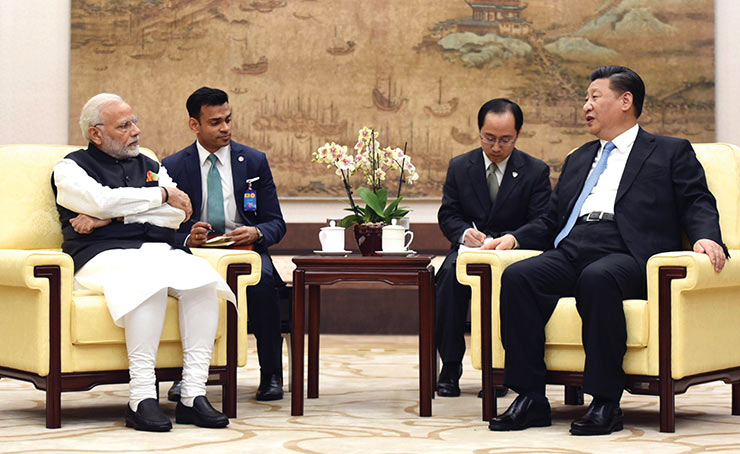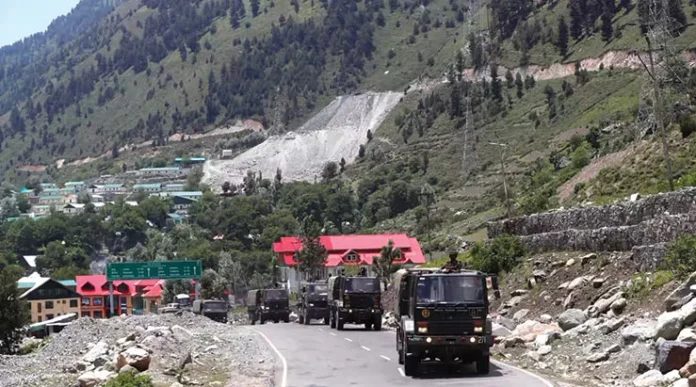China’s strength is highly overrated by friends and foes all over the world. The Chinese armed forces are dens of corruption, nepotism and bureaucratic red-tape. Many Chinese army Generals – including those nearing retirement have in their entire length of service never participated or commanded troops in a real war.
In terms of sheer numbers, China has approximately 975,000 active duty personnel in the People’s Liberation Army (PLA). The People’s Liberation Army Navy (PLAN) – is numerically the largest navy in the world with approximately 355 ships and submarines. The People’s Liberation Army Air Force (PLAAF) and PLAN Aviation together — are the third largest in the world, with over 2,800 aircraft of which approximately 2,250 are combat aircraft including fighters, strategic bombers, tactical bombers, and attack aircraft, and the People’s Liberation Army Rocket Force (PLARF) which controls PRC’s strategic land-based nuclear and conventional missile forces and associated bases.
On the basis of this, any outsider may say that China has a large military, but that is the half-truth. In reality, new technologies are useless without the well-trained and motivated soldier behind the gun or weapon systems. The grim reality is that the Chinese PLA today has an increasingly impressive array of high-tech weapons and equipment but does not have the experience to use them in combat. Analysts aware of the ground realities argue that China’s forces are not well-equipped for modern warfare and its military doctrine is outdated. The Chinese military is bogged down with corruption and bureaucratic red tape.
China’s biggest weakness is its lack of combat experience. Unlike their counterparts in other countries, many Chinese officers have been promoted to the rank of General not because of their leadership skills in military operations but because of their political connections and alignment. On the face of it though the Chinese military, officially known as the People’s Liberation Army (PLA), appears to be one of the largest and most powerful armed forces in the world it is riddled with many drawbacks and challenges. Some of the notable drawbacks in the Chinese military include:
Analysts aware of the ground realities argue that China’s forces are not well-equipped for modern warfare and its military doctrine is outdated. The Chinese military is bogged down with corruption and bureaucratic red tape
Bureaucracy: The Chinese military is known for its complex bureaucracy, which leads to delays and inefficiency. In 2015, it took the Chinese military over a month to respond to a cyber-attack on its systems. Bureaucratic red-tapism makes it difficult for soldiers to advance their careers, as they often have to navigate complex political and social networks.
Corruption: Corruption is a widespread problem in the PLA. It is one problem that can undermine morale, discipline, and combat effectiveness.
Transparency: The Chinese military is one of the least transparent in the world. The Chinese government does not release much information about its military budget, weapons programs, or force structure. This lack of transparency makes it difficult to assess the PLA’s capabilities and intentions.
Technology Gap: While China has made significant advancements in military technology, it still lags behind the United States in areas, like stealth technology, cyber capabilities, and power projection capabilities. Closing this technology gap remains a challenge.
Defective and unreliable equipment: Some Chinese military equipment has been found to be defective or unreliable. This could be a major problem in a war when soldiers need to be able to rely on their weapons and equipment.
Logistics and Mobility: The vast size of China and its diverse terrain can pose logistical challenges for military operations. Rapid deployment and sustained logistics support across the country can be difficult, especially in remote or mountainous regions.
Quality vs Quantity: China has a large standing military force, but the quality of its personnel and equipment can vary. Maintaining a high level of readiness and competence across its massive military is a significant challenge.
Civil-Military Relations: The PLA operates under the ultimate authority of the Chinese Communist Party, and its role extends beyond defence into politics and governance. This tight integration can have implications for military professionalism and decision-making.
Regional Tensions: The Taiwan Strait remains a contentious issue, and tensions in the South China Sea persist. These territorial disputes create the potential for conflict with neighbouring countries and could involve the United States.
Cybersecurity Threats: China has been accused of engaging in cyber espionage and cyberattacks against other nations. Such activities can lead to diplomatic tensions and retaliation.
Human Rights Concerns: Reports of human rights abuses in Xinjiang and Tibet have raised concerns and prompted calls for international action. These issues can impact China’s global image and relations with other countries.
Modernisation Challenges: While China has made significant strides in modernizing its military, transitioning from a large, outdated force to a more technologically advanced one can be challenging and may not be fully achieved in the near term.
Nuclear Arsenal: China’s nuclear arsenal is smaller than those of the United States and Russia, but it is still a significant factor in global security. Maintaining a credible nuclear deterrent while avoiding an arms race is a complex balancing act.
Ageing population: China’s population is ageing rapidly. This could make it difficult to recruit and retain enough qualified personnel for the PLA. Manpower shortage is a big problem in the PLA’s ground force, naval force, and air force.

Chinese PLA – a ‘Paper Tiger’
Above all, unlike the Indian Army, the Chinese PLA seems to be a ‘Paper Tiger’ with no battlefield experience. The last major war that Beijing fought was the Sino-Vietnamese War in 1979. Since then China has not been involved in any full scare war – except a few border skirmishes while its air force has not participated in a major conflict since 1958.
In 1975 most of the current officers and men were babies. Even otherwise while the Chinese army had numerical superiority in the war in almost every aspect – men, guns, tanks – it failed to achieve a decisive victory against the Vietnamese, because their troops were no match for the better-trained and combat-experienced Vietnamese soldiers.
Today even in so-called peace time, the primary objective of the Chinese military is to preserve the power of the Chinese Communist Party.
As a result, the Chinese military is simply not half as good as it should be. The generals are party bigwigs, not military generals. The soldiers are mostly semi-literate rural peasants. There are no professional non-commissioned officers. Instead of learning to be a good soldier an average Chinese military man spends a lot of time political indoctrination and studying party propaganda
In the Chinese Communist Party structure, there are multiple mechanisms to control the People’s Liberation Army. These include an extensive network of political commissars and party committees that penetrate all levels of the military. All officers and enlisted personnel are party members, reinforcing the political allegiance of men and women in uniform. Every member of the military has a political dossier that includes assessments of their reliability and attitude. The Chinese troops spend 20 to 30 per cent of their time studying communist ideology. Most of the time the troops are deployed to suppress rebellions leaving very little time for war-fighting.
Hub of corruption and nepotism
Corruption is another serious problem in the Chinese military. A number of cases have come to light where senior officers have been bribed by contractors to win contracts.
Here are some specific examples of corruption and bureaucracy in the Chinese military:
- In 2013, Lt Gen. Gu Junshan was sentenced to life imprisonment for embezzling over US$320 million
- In 2014, Major General Yang Jinshan was sentenced to 15 years in prison for taking bribe
- In 2014, former CMC vice chairman, Xu Caihou was arrested for participating in a “cash for ranks” scheme. This was followed up by the arrest of another former CMC vice chairman, Guo Boxiong, on similar charges.
- In 2016, Admiral Wang Shouye, former vice chairman of the Central Military Commission, was expelled from the Communist Party of China for corruption and other violations.
The following are some of the causes of corruption in the Chinese military:
- Lack of transparency and accountability in the military bureaucracy.
- Lack of a strong legal framework to combat corruption.
- A culture of impunity in the Chinese military, which makes it difficult to prosecute cases of corruption.
The Chinese government has taken some steps to address these problems. For example, it has increased the level of civilian oversight of the military and has launched a number of anti-corruption campaigns.
In the last nearly one decade since Xi assumed power, more than 1,600 politicians and bureaucrats have been arrested, purged, or sentenced for taking part in corruption.
Recently the PLA Rocket Force chief General Li Yuchao and his deputy mysteriously vanished and were reportedly “taken away” for allegedly being involved in corruption.
This comes soon after foreign minister Qin Gang was replaced and Gen Wei Fenghe was asked to step down as the Chinese Defense minister. Fenghe has not been seen for months.
“We will investigate every case and crack down on every corrupt official. The Chinese military governs according to the law, and shows zero tolerance of corruption.” Chinese spokesperson Wu Qian told reporters at a briefing.
Final Thoughts
Even if we leave corruption aside, the root cause of the problem is that China does not have a professional army. The PLA is the armed wing of the communist party. Due to low remuneration and operational hardships military service is looked down upon and considered a poor alternative to working in the private sector.
As a result, the Chinese military is simply not half as good as it should be. The generals are party bigwigs, not military generals. The soldiers are mostly semi-literate rural peasants. There are no professional non-commissioned officers. Instead of learning to be a good soldier an average Chinese military man spends a lot of time studying political indoctrination and party propaganda.
–The writer is a seasoned media professional with over three decades of experience in print, electronic, and web media. He is presently Editor of Taazakhabar News. The views expressed are of the writer and do not necessarily reflect the views of Raksha Anirveda
–The writer is a seasoned media professional with over three decades of experience in print, electronic, and web media. He is presently Editor of Taazakhabar News. The views expressed are of the writer and do not necessarily reflect the views of Raksha Anirveda






